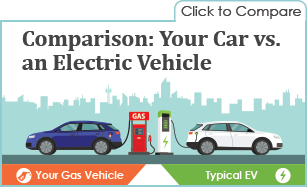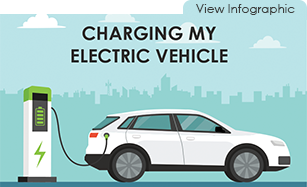Electric & Plug-In Hybrid Electric Vehicles
E-Updates
Electric vehicles (EVs) have a battery instead of a gasoline tank, and an electric motor instead of an internal combustion engine. Plug-in hybrid electric vehicles (PHEVs) are a combination of gasoline and electric vehicles, so they have a battery, an electric motor, a gasoline tank, and an internal combustion engine. PHEVs use both gasoline and electricity as fuel sources. More on PHEVs.
Watch the video to learn how electric vehicles and different types of plug-in hybrid electric vehicles work.
Visit EV Myths to learn even more facts about electric vehicles.
Emissions
EVs produce no tailpipe emissions. While charging the battery may increase pollution at the power plant, total emissions associated with driving EVs are still typically less than those for gasoline cars—particularly if the electricity is generated from renewable energy sources like wind.
PHEVs produce tailpipe emissions when gasoline is being used as a fuel source.
To estimate the greenhouse gas emissions associated with charging and driving an electric or plug-in hybrid electric vehicle where you live, visit our Greenhouse Gas Emissions for EVs and PHEVs Calculator.
Charging
Depending on how far you drive each day, you may be able to meet all your driving needs by plugging in while at home. Most EVs can be charged with a standard 120 V outlet. To charge the vehicle more quickly, you may want to install a dedicated 240 V outlet or charging system. You may also be able to plug in at your workplace, or at one of the growing numbers of public charging stations.
- Learn more about EV charging
- Learn more about charging equipment
- ENERGY STAR certified EV charging equipment
- Public charging stations
Driving Range
The number of miles an EV will travel before the battery needs to be recharged is often less than the distance your gasoline car can travel before being refueled, but typically is still enough to accomplish the average person’s daily driving needs. An electric vehicle’s fuel economy is reported in terms of miles per gallon of gasoline-equivalent (MPGe). Think of this as being similar to MPG, but instead of presenting miles per gallon of the vehicle’s fuel type, it represents the number of miles the vehicle can go using a quantity of electricity with the same energy content as a gallon of gasoline. This allows you to compare an EV with a gasoline vehicle even though electricity is not dispensed or burned in terms of gallons.
PHEVs typically have driving ranges that are comparable to gasoline vehicles. PHEVs have two fuel economy values: one for when the vehicle operates primarily on electricity (listed in terms of MPGe), and one for when the vehicle operates only on gasoline (listed as MPG).
Find the driving range and charge time for EVs and PHEVs on the Fuel Economy and Environment Label or Fuel Economy
Note: The EPA estimates, including EV range, are meant to be a general guideline for consumers when comparing vehicles. Just like “your mileage may vary” for gasoline vehicles, your range will vary for EVs. In particular, factors like cold weather, accessory use (such as A/C), and high-speed driving can lower your vehicle’s range significantly.
Visit Fuel Economy in Cold Weather to get tips on maximizing your electric car’s range in extreme temperatures.
Learn more about the fuel economy label
Availability
EVs and PHEVs are now available in multiple vehicle classes. There are currently over 50 EV and PHEV models on the market, and more models are expected to be released in the coming years. Visit fueleconomy.gov for a full list of options. Not all models are available in all 50 states.
A Little More on PHEVs . . .
Some PHEVs operate exclusively, or almost exclusively, on electricity until the battery is nearly empty. Then, gasoline is burned in the engine to provide additional power. Other PHEVs—sometimes called “blended mode” PHEVs—use gasoline and electricity together to power the vehicle while the battery has charge.
Read the Recommendations of the Federal Electric Vehicle Working Group (pdf) (571 KB, November 2024), which include strategies for EV adoption across the U.S. and a sustainable, accessible, and resilient EV ecosystem.



